Transition from a typical data center network to SDN
Transition from a typical data center network to SDN
Breakthrough technologies change strategies
The explosive growth that the data center network (DCN) is currently demonstrating is steadily turning these networks into a key element of the corporate information and computing infrastructure, especially when servicing critical service systems and managing key information resources. As the corporate architecture of DCN expands, all kinds of new applications are deployed in data centers, thanks to, on the one hand, advances in communication technology and, on the other hand, the growing popularity of the Internet and mobile applications. Companies are also starting to introduce new work models that use cloud jobs and new business analysis methods that require data warehousing and the use of deep data mining. All of these breakthrough changes not only increase companies' dependence on data centers, but also accelerate the emergence of DCN implementation strategies with scalable updates.
In order for data center networks to keep up with the exponential growth of data from new sources, new server capabilities are needed for both storing and processing more and more complex service interactions. However, the architecture and technology of traditional data centers no longer meet the emerging requirements for high efficiency, intelligence and usability. This strategic challenge led to the emergence of software-defined network technology (SDN). SDN technology provides network virtualization capabilities, separates control and redirection planes, implements logically centralized management and opens up network capabilities for higher-level applications. SDN is particularly suited for implementing data center networks with powerful functionality that supports centralized network management, extensive redirection, virtual machine deployment, intelligent migration, multi-user virtual networks, and the infrastructure-as-a-service (IaaS) principle. It can be concluded that the technological trend towards cloud solutions based on SDN determines the future of data center networks.
Among the available SDN technologies, the methodology of using an SDN controller and a superimposed network to ensure an adequate level of redirection and separation of control is widely recognized. This technique provides for centralized delivery of policies through an SDN controller, the ability to virtualize network resources and plan them flexibly. Infrastructure network virtualization is based on overlay technologies such as Virtual Extensible LAN (VXLAN). The overlay protocol frees services and resources from the constraints associated with their physical location and allows you to create a large logical layer 2 network for sharing resources in data centers.
VXLAN extends L2 networks with MAC-in-UDP encapsulation and takes advantage of L3 networks for extensive load balancing, fast convergence and high reliability, which enriches the capabilities of L2 networks. In addition, VXLAN uses a 24-bit VXLAN network identifier (VNI) field to identify L2 networks, which can support over 16 million network segments. Thus, the limitation of 4096 VLAN imposed by traditional L2 networks is overcome. Tunnel entry and exit nodes of a VXLAN are called virtual tunnel endpoints (VTEP), they encapsulate and decapsulate VXLAN packets. The Huawei Cloud Fabric solution for data center networks supports both hardware and software VTEP to meet all kinds of customer requirements.
')
In the evolution of SDN, software-defined and traditional networks will coexist for a while for various business reasons. So how can a traditional network evolve gently in SDN? In general terms, such a transition can be implemented in three ways:
- Scenario 1: Build new SDN delivery points within the existing data center
- Scenario 2: Deploying SDN on new devices for traditional point-of-delivery expansion projects
- Scenario 3: Reuse of existing network devices to upgrade a traditional data center network to an SDN network
Network Evolution Solutions
Scenario 1: Build new SDN delivery points within the existing data center
The data center network can gradually transform into SDN by building new SDN delivery points in existing data centers with the following prerequisites:
Prior to the transformation of traditional data centers to data centers based on SDN, customers want to ensure the viability of the SDN data center by building a new flexible SDN-based delivery point and testing new services through this point. Services in new delivery points do not require interaction with traditional delivery points.
Customers build one or more flexible SDN-based delivery points and launch new services on them, or migrate some of the existing services to new delivery points. New delivery points require L3 communication with existing delivery points through the main data center devices. There is no need for an L2 connection between new and old delivery points.
In this development scenario, there are the following service requirements:
- SDN is deployed on a new delivery point, new services are launched on it independently.
- SDN delivery points do not require interaction with traditional delivery points.
- In case of need, communication between traditional and SDN delivery points is carried out via L3-forwarding by the main data center devices.
Network Design:
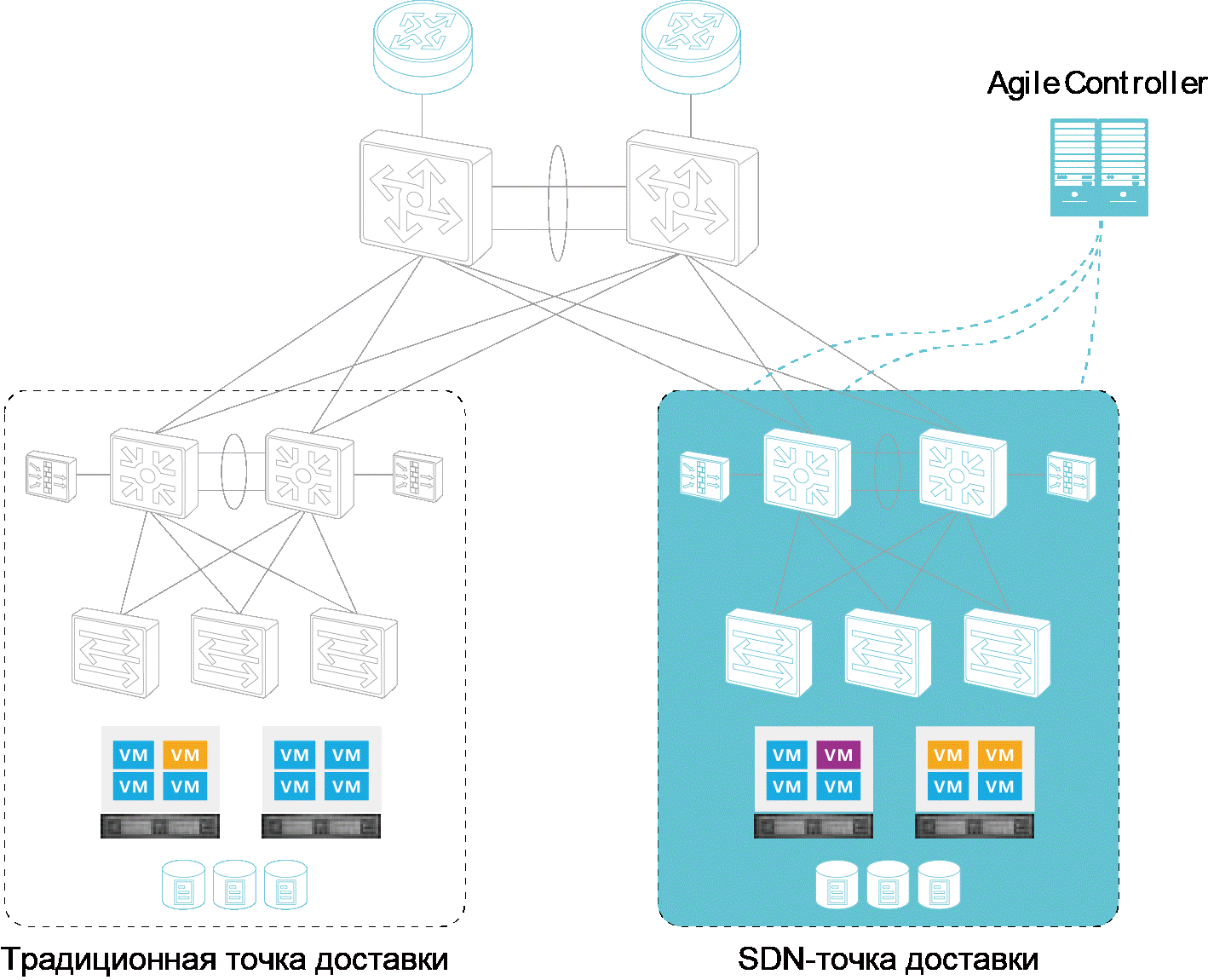
Traffic redirection process:
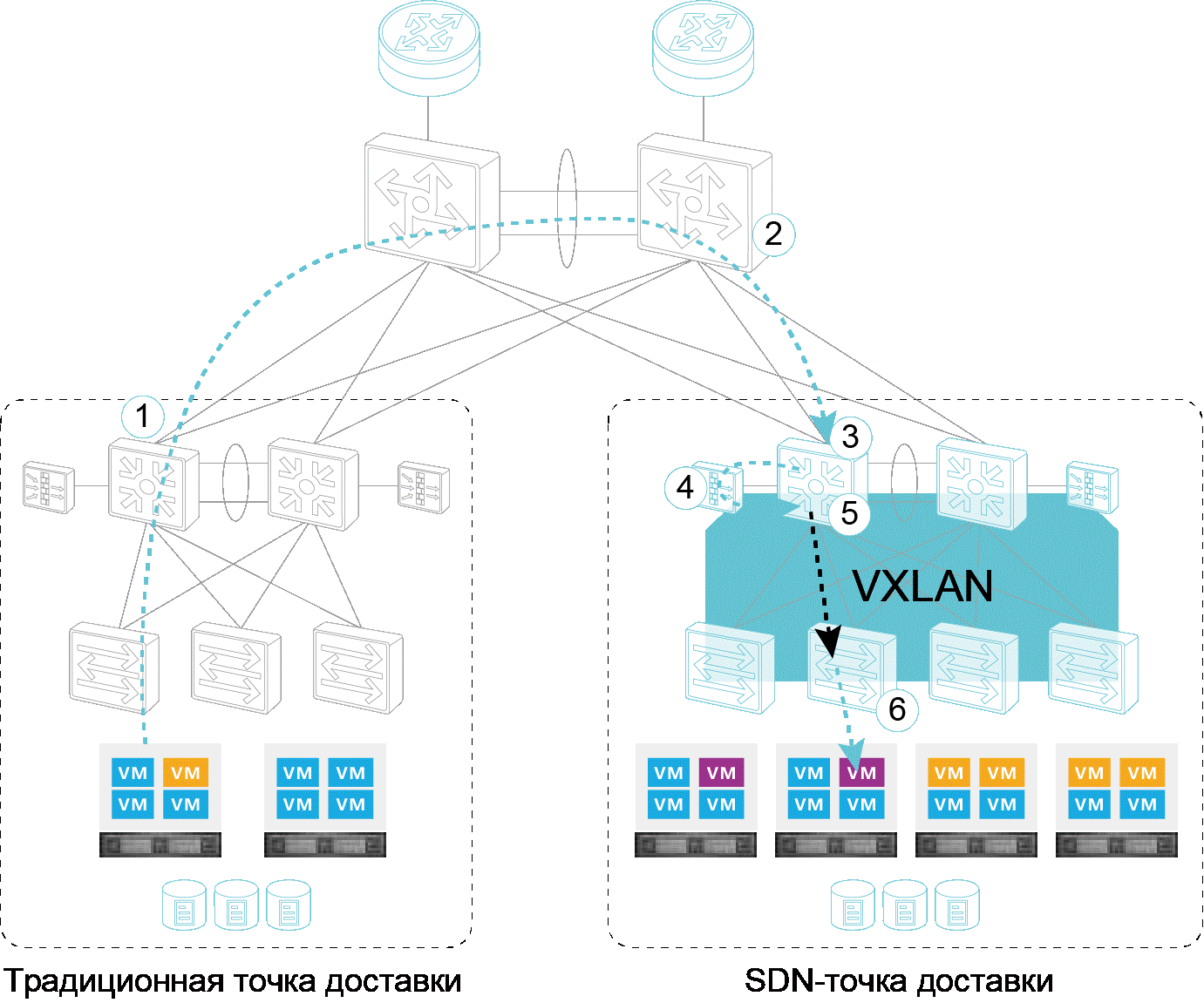
The process of redirecting traffic between traditional and SDN delivery points is as follows:
The L3 gateway on a traditional delivery point forwards traffic to the primary switch based on the routing table.
The primary switch forwards traffic to the gateway switch to the SDN delivery point.
The gateway switch finds the appropriate route and redirects traffic to the firewall.
The firewall finds the appropriate route and forwards the traffic to the virtual routing and forwarding system (VRF) to which the destination host belongs.
The gateway finds the VXLAN flow table for the destination host, encapsulates the packets in the VXLAN packet format, and then sends them to the destination VTEP.
The destination VTEP decapsulates the VXLAN packets and forwards the source packets to the destination host based on the corresponding MAC address information.
Scenario 2: Deploying SDN on new devices for traditional access point expansion projects
This scenario is best for the following conditions:
Customers want to expand existing access points and implement SDN technology without affecting the existing network at access points. Extending an SDN network requires only a L3 connection to an existing network.
Customers want to migrate computing nodes from the existing network to new SDN gateway devices and implement L2 communication between the original network and the SDN. An example of such a situation is the expansion of the existing network cluster.
In this development scenario, there are the following service requirements:
- Traditional delivery points need expansion, and the new network uses the SDN solution. The current deployment and network organization of services remains unchanged, existing devices are connected to the new network to form larger delivery points.
- A traditional network at the point of delivery establishes an L2 or L3 connection with the new software-defined network.
1. L3 communications • Network design:
The existing regular network and SDN are connected to the main data center node via aggregation switches. Aggregating switches of two networks can be connected directly for greater efficiency in forwarding traffic in the east-west direction and reducing the load on the main node.

• Traffic redirection process:
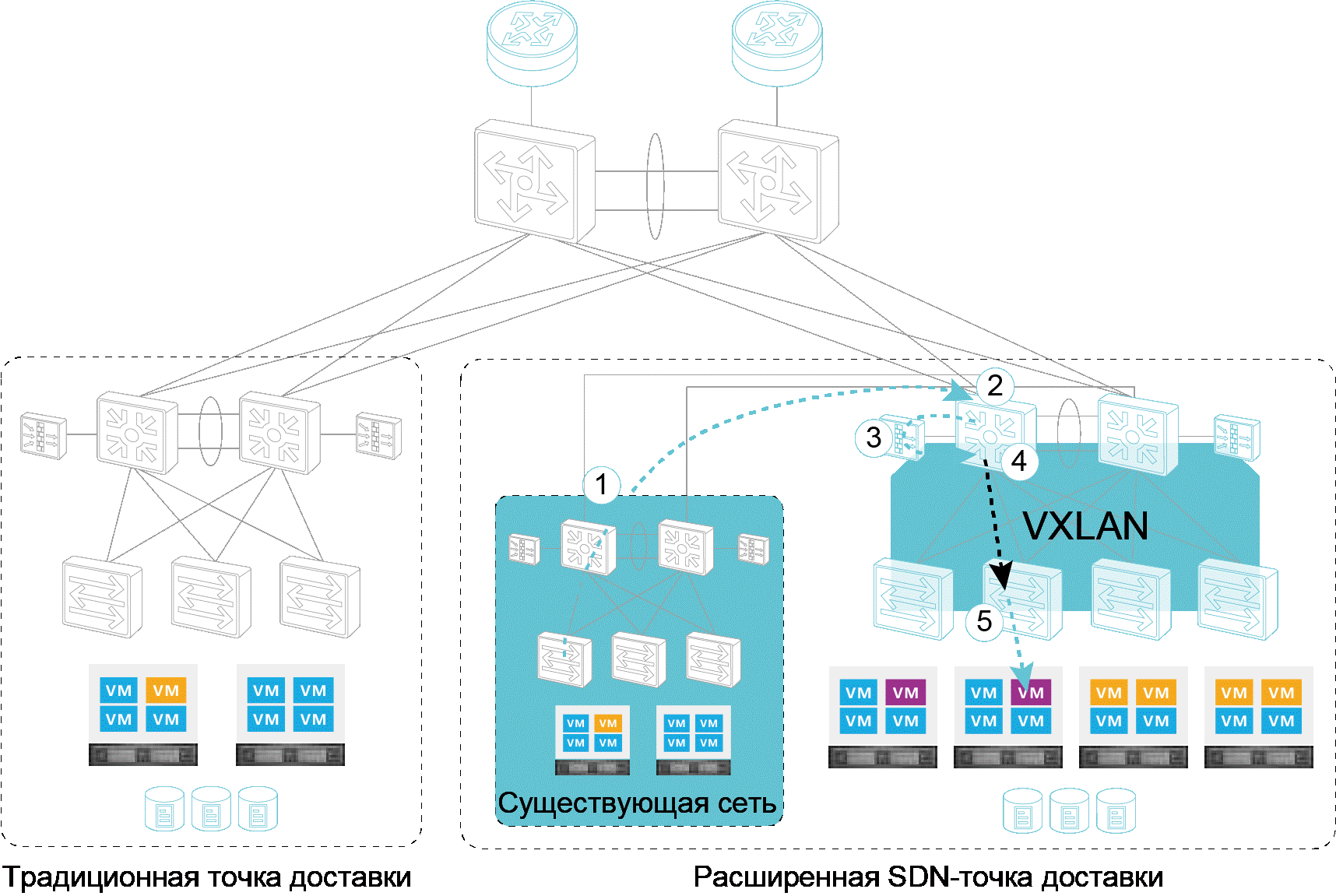
The process of redirecting L3 traffic between the traditional and SDN networks in the extended SDN delivery point proceeds as follows:
The traditional network L3 gateway forwards traffic to the gateway switch in the SDN network based on the routing table.
The gateway switch finds the appropriate route and redirects traffic to the firewall.
The firewall finds the appropriate route and forwards the traffic to the VRF to which the destination host belongs.
The gateway finds the VXLAN flow table for the destination host, encapsulates the packets in the VXLAN packet format, and then sends them to the destination VTEP.
The destination VTEP decapsulates the VXLAN packets and forwards the source packets to the destination host based on the corresponding MAC address information.
2. L2 communications • Network design:
The traditional network connects to the L2 bridge in the new SDN network. L2 bridges map VLAN identifiers used in a traditional network to VNIs used in an SDN network, establishing an L2 connection between two networks. The L3 gateway for traditional network hosts can be migrated to gateway switches in the SDN network. Extended SDN delivery points connect to the main node of the data center switch through new gateway switches.
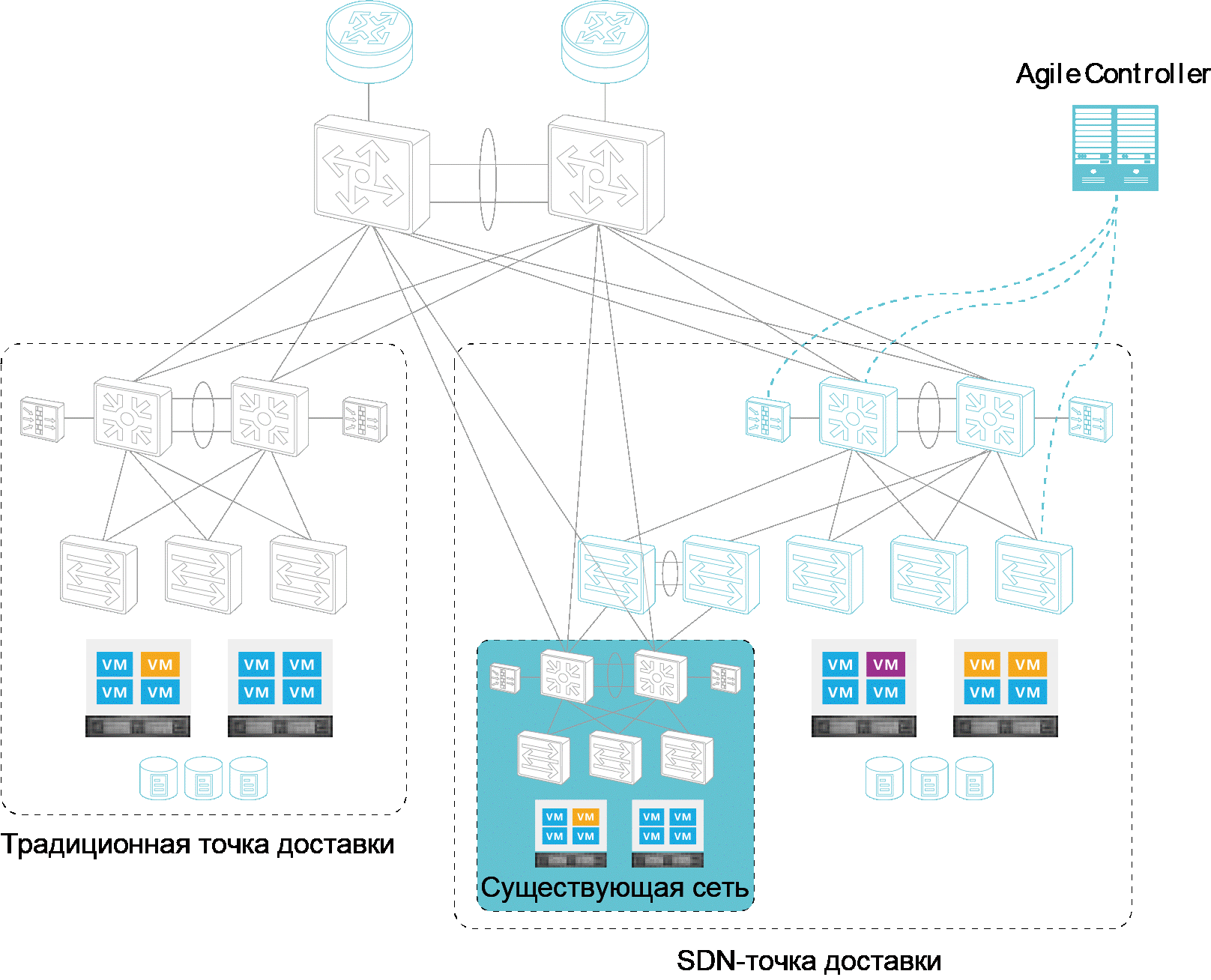
• Traffic redirection process:

The process of redirecting L2 traffic between the traditional and SDN networks in the extended SDN delivery point proceeds as follows:
The traditional network aggregator switches the L2 traffic to the L2 bridge in the SDN network via the Eth-Trunk channel.
The L2 bridge encapsulates VXLAN packet format packets based on the VXLAN-VNI mapping controller, finds the destination host in the VXLAN flow table, and redirects the packets to the destination VTEP.
The destination VTEP decapsulates the VXLAN packets and forwards the source packets to the destination host based on the corresponding MAC address information.
Scenario 3: Reuse of existing network devices to upgrade a traditional data center network to an SDN network
Customers can reconstruct the network and infrastructure of a work or test delivery point to an SDN delivery point to evaluate the SDN solution and experience the services of the SDN network. Through the use of existing network devices, this method allows customers to build a software-defined network with less cost.
• Network design:
In this scenario, a hybrid overlay solution can be used. Huawei's CloudEngine 1800V switches can be hosted on servers and perform the functions of VTEP nodes of a VXLAN superimposed network. Huawei CloudEngine physical switches act as north-south gateways and decapsulate VXLAN traffic passing through firewalls, as well as redirected traffic within the delivery point. Existing access switches are reused in the underlying network.
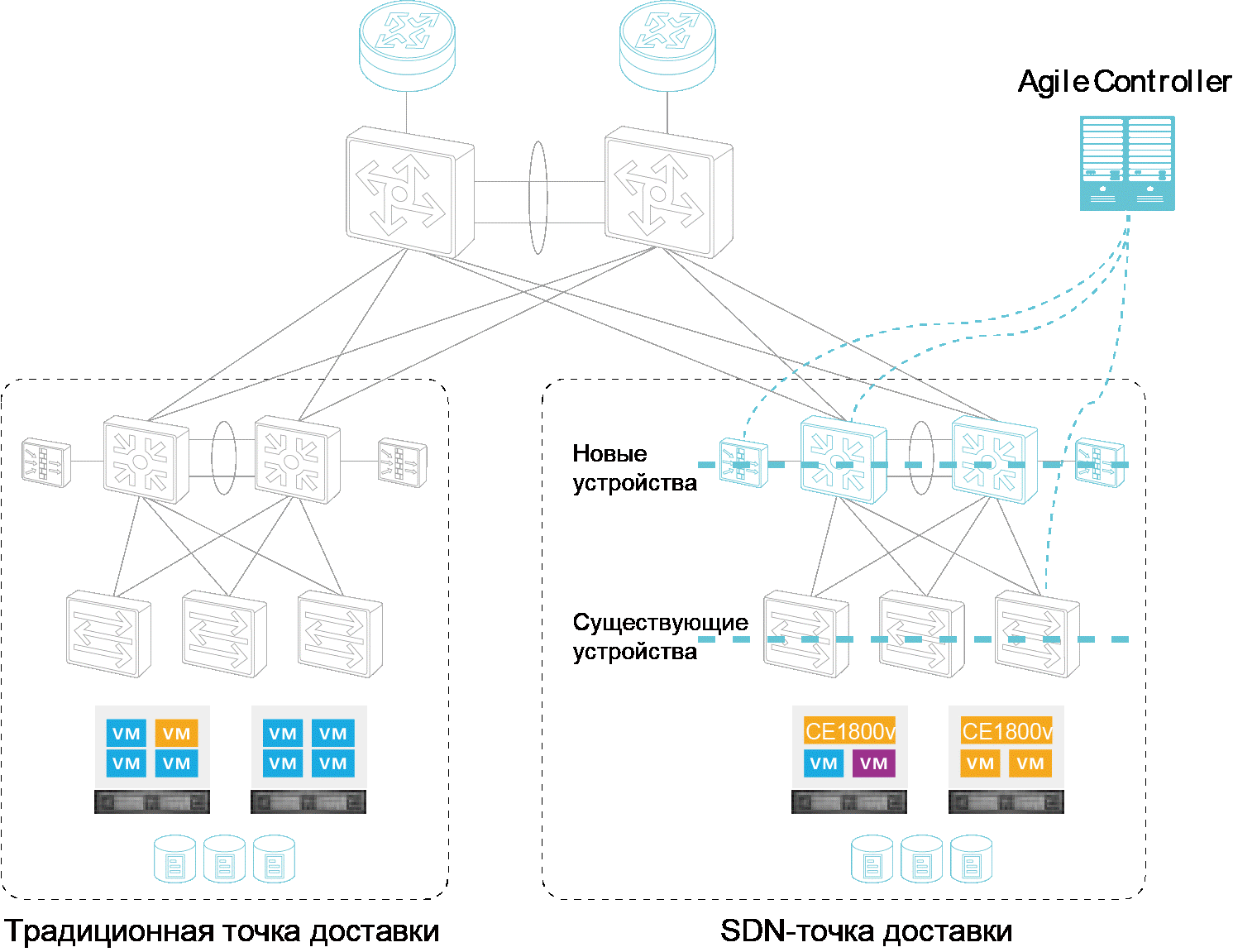
• Traffic redirection process:

The process of redirecting traffic between traditional and SDN delivery points is as follows:
The L3 gateway on a traditional delivery point forwards traffic to the primary switch based on the routing table.
The primary switch forwards traffic to the north-south gateway switch on the SDN delivery point.
The gateway switch finds the appropriate route and redirects traffic to the firewall.
The firewall finds the appropriate route and redirects traffic to the VRF, to which the destination host is located on the north-south gateway switch.
The north-south gateway switch finds the VXLAN flow table for the destination host, encapsulates the packets in the VXLAN packet format, and then sends them to the destination VTEP (CloudEngine 1800V).
The destination VTEP decapsulates the VXLAN packets and forwards the source packets to the destination host based on the corresponding MAC address information.
The brilliant future of SDN in data center networks
Data center networks are rapidly expanding to meet the exponentially growing needs of services. According to forecasts, by 2020, tenfold growth is expected in solutions for data center networks around the world. Data center development also requires progress in managing network resources. Industry trends show that SDN technology will become the foundation for data center networks. The main concern of operators and companies is how to ensure the transformation of traditional networks into SDN solutions, minimizing the impact on existing services and the amount of investment required. To ensure this transition, Huawei has flexible SDN solutions and extensive SDN deployment experience. Huawei can tailor network evolution solutions that are most suitable for the scenarios and requirements of your applications for the sake of your company's business success.
Author: Denis Serechenko, Business Development Director, Huawei Enterprise Business Group in Russia.

More information on the site - e.huawei.com/ru
Source: https://habr.com/ru/post/337918/
All Articles